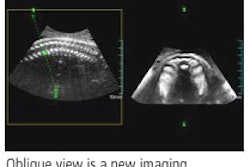CHICAGO - One piece of conventional wisdom has been overturned in a study using contrast-enhanced ultrasound (CEUS) that showed almost all hepatic metastases exhibit arterial hypervascularity, including those generally thought to be hypovascular.
In addition, the rapid washout seen by researchers may help differentiate metastases from primary liver tumors and may explain the generally hypovascular appearance of metastases on contrast-enhanced CT or MR, said Dr. Jessica Murphy-Lavallee, who presented her group's work at the RSNA meeting on Sunday.
The researchers from the University of Toronto may have contradicted popular belief largely because they were the first to look at the question.
"To our knowledge, no one has specifically studied contrast-enhanced ultrasound characteristics of metastases," Murphy-Lavallee noted.
At least 47 patients with 50 biopsy-proven metastases -- including 28 colorectal, six neuroendocrine, five breast, five pancreatic, and six others -- were evaluated in the study. CEUS was performed with low-mechanical-index (low-MI) continuous scanning with Definity contrast microspheres (Bristol-Myers Squibb, Billerica, MA).
Two radiologists reviewed moving and static images for intensity of arterial phase enhancement compared to the parenchyma, the presence of dysmorphic vessels, and the pattern of enhancement -- whether homogeneous, heterogeneous, rim, or none.
In the rare cases of disagreement, the radiologists' readings were resolved by consensus.
Time to peak arterial enhancement and the beginning of washout were observed from movie files, timed from the end of a 10-cc saline flush injected immediately after the 0.2-cc bolus of contrast. The same protocol was used in all cases, Murphy-Lavallee said.
Eighty-six percent of the metastases were found to be hypervascular, with 100% agreement between the radiologists in those readings. Some 42% of lesions showed dysmorphic vessels.
Another unexpected finding was in the patterning observed, Murphy-Lavallee suggested. "It is believed that most metastases have rim enhancement," she noted, while in the Toronto study less than half (44%) exhibited that pattern.
Time from peak arterial enhancement was short, occurring between eight and 27 seconds. All of the metastases showed complete washout, in a time frame ranging from 13 to 45 seconds.
The very homogeneous and rapid washout seen in metastases would be distinct from the much longer washout time seen in hepatocellular carcinoma as described in another study by the same group, Murphy-Lavallee noted in response to a query.
By Tracie L. Thompson
AuntMinnie.com staff writer
November 27, 2005
Related Reading
Ultrasound contrast enhances liver imaging, May 11, 2005
Contrast US pinpoints focal liver lesions, results in cost-savings, March 25, 2005
Breath-hold technique comparable to respiratory-triggered MR for liver imaging, March 16, 2005
Exam technique critical in liver ultrasound, October 22, 2004
Copyright © 2005 AuntMinnie.com



















